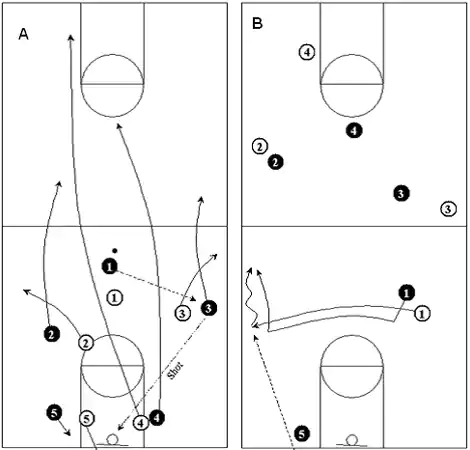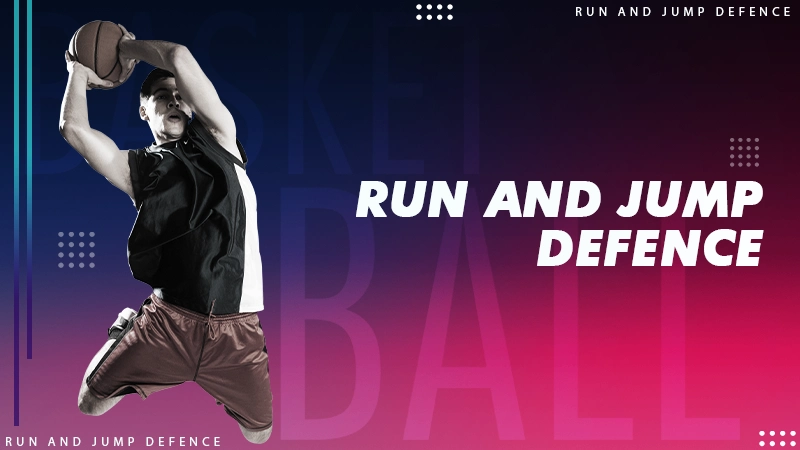The aggressive, man-to-man basketball run and jump defensive strategy brings together traditional man-to-man defense with dynamic, spontaneous traps and switches. It is a very aggressive style of play that tries to break up the rhythm of the opponent’s offense, force turnovers, and create chaos for the opposing team. As a response to the methodical offense, the run-and-jump defense feeds on athleticism, communication, and anticipation.
In this article, we will discuss the principles, mechanics, advantages, and challenges of the run-and-jump defense.
Let’s get started.
What is the Run and Jump Defense
What is the run and jump defense? This question is often asked by beginners who are starting out their basketball journey.
In the game of basketball, one of the most popular sports in the world, run and jump defense plays an important role.
The run-and-jump defense is a full-court man-to-man press that uses jump switching and trapping opposition players. This defense is best suited for a team that wants to play an increased-tempo game. This defense is not suitable for big and slow teams, as rotations require quick movements.
In this defense, there are no set spots on the court for trapping and switching. It is an instinctive strategy that depends on the players.
It is an effective strategy that forces the guards out of their comfort zone with a lot of pressure. Furthermore, it is a man-to-man press and not a zone press.
Unlike the traditional defense, where roles and matchups are more inflexible, the run-and-jump defense requires the defender to react instinctively to the game situation. Players must jump to the new position based on the movement of the ball and their teammates. It creates fluidity and unpredictability in the defensive structure.
Principles of the Run-and-Jump Defense
Now that you’ve learned what is the run-and-jump defense, it’s time to look at the key principles of this defense.
This is the list of basic principles that make the run-and-jump defense successful.
Pressure on the Ball
Opponents apply constant pressure on the ball handler to disrupt their vision and decision-making. The defenders pursue the ball handler with aggressive but disciplined movements. It forces hurried passes or dribbles from the ball handler.
Help and Rotation
In this defense, players help their teammates and rotate positions. Whenever one defender “jumps” to a new position, other players rotate to fill the gaps. This type of strategy allows the teams to fill in gaps.
Communication
For good gameplay, effective communication is required. Defenders must signal verbally to make sure that everybody is on the same page. This will ensure that there are no scoring opportunities.
Anticipation and Instinct
For a good game, the Defenders must read the offense, predict passes, and time their movements to create maximum disruption. For this strategy, players have to make split-second decisions.
Conditioning and Athleticism
We all know that the run-and-jump defense is very physically demanding. This is why players must be in great shape to maintain the high energy levels to play at that level.
The Mechanics of the Run-and-Jump Defense
There are a few things involved in this defense. All the run and jump press options are explained here.
Setting the Trap
The trap is the foundation of the run-and-jump defense. When two defenders converge on the ball handler, they cut off the passing lanes and force the ball-handler to make a quick decision. The trap happens when the ball-handler crosses half-court or moves toward the sideline. Half-court jump presses are pretty common in this defense.

Jumping to a New Position
Whenever a defender commits to trap or to help, another defender jumps into that player’s position. This transition is pretty smooth. It does not give the opposition any chance to exploit.

Forcing turnovers
The main objective of the run-and-jump defense is to force turnovers. The teams will apply pressure relentlessly so that turnovers can be committed through errant passes, bad shots, or violations.
Advantages of the Run-and-Jump Defense
There are many advantages to this strategy. Here is the list of primary advantages why a team must employ run and jump defense.
- The unpredictable nature of the run-and-jump defense increases the tempo of the game and disrupts the offense strategy of opponents.
- The aggressive trapping and constant movement create opportunities for steals and deflections. This leads to more opportunities for the defensive team.
- This defense engages the entire team, leading to unity and shared responsibility.
- This strategy is also used to counter skill ball handlers. Defense can overwhelm them with this strategy.
- This allows the coach to play a lot of athletes. It is a great thing for a team.
- The fluidity of this method allows the defensive team to handle various play styles.
- This style is difficult for teams to simulate in practice.
Challenges of the Run-and-Jump Defense
Not everything is risk-free. The run-and-jump defense also comes with certain challenges if not executed perfectly. Here is the list of challenges of this defense.
- High Chances of Fouls: Teams employ aggressive defense that tends to lead to fouls. Some impulsive trapping or ill-timed switches tend to create reach fouls, blocking fouls, or defensive failures.
- Susceptibility to Quick Passing: If the offensive team is quick to react, they can exploit the gaps created by the defensive rotations. Teams with great skills can neutralize this defense.
- Physical Requirements: This defense requires players to give their all. It uses a great amount of energy that gradually causes players to tire.
- Requires High Amount of Communication: The key aspect for the success of this defense is communication. The possibility of miscommunication can make it easy for the opposition to score.
- Hard to Execute Without Athleticism: Teams without speed, agility, or stamina cannot execute this well. This strategy requires a team with players who can easily switch and recover quickly.
When to Use the Run-and-Jump Defense
This defense is particularly effective in various scenarios of basketball, one of the hardest sports in the world. These scenarios are:
Against Slower Teams:
Teams that have slower ball-handlers are more likely to struggle against this defense. So, it would be a great weapon to use against them.
When Trailing Late in Games:
If teams are trailing late in games, then they can employ this strategy. The aggressive nature of this defense makes it ideal for creating turnovers and quick scoring opportunities.
To Change Momentum:
It is also a good strategy to change momentum towards yourself. If a team is struggling defensively or needs to disrupt an opponent’s run, the run-and-jump defense can be very effective.
Conclusion
The run-and-jump defense is a dynamic and thrilling strategy that brings the best of man-to-man defense with aggressive trapping and constant rotation.
This strategy requires high levels of athleticism, communication, and teamwork to be able to effectively execute. Its potential risks are fouls and defensive breakdowns, but the possibility of disrupting offenses and forcing turnovers makes it important.
Whether you’re a coach looking to implement this strategy or a player seeking to understand it better, mastering the principles and mechanics of the run-and-jump defense can be a game-changer.
Hope this article helps you in your discovery of what is the run and jump defense. Do check out our other posts.





